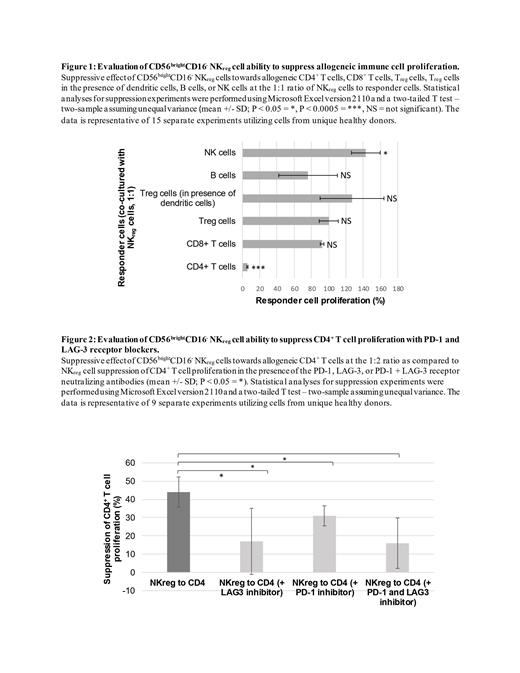Background: Chronic graft-versus-host disease (cGvHD) is a major cause of morbidity and mortality after Hematopoietic Stem Cell Transplantation (HSCT). Previously, in large cohorts of HSCT patients we identified increased numbers of CD56 bright, granzyme B -, perforin - NK cells (NK reg) to be associated with a lack of cGvHD development. Transcriptome analysis of HSCT patient samples identified a unique transcriptome among the CD56 bright NK reg cells which associated with patients who failed to develop cGvHD, including overexpression of genes IL7R, GPR183, and Granzyme K, and low expression of genes such as perforin, granzyme B, and CD16. We then utilized the transcriptome information and further cell phenotyping to determine the optimal sorting approach for viable NK reg cells to allow for functional analysis by the sorting of CD56 brightCD3 -CD16 - cells. Functional analysis suggested that the NK reg population suppresses CD4 + T cells through a non-cytolytic, and direct cell-cell contact-dependent mechanism, though the exact receptor and ligand interaction of which CD4 + T cell populations are impacted is unknown. We hypothesized that the NK reg cell suppressive mechanism may be more specific than the more widely studied regulatory cell population, T reg cells, by suppressing CD4 + T cell subpopulations involved in inflammatory responses.
Methodology: To investigate the suppressive capacity of NK reg cells, the cells were isolated from healthy donor peripheral blood and co-cultured with allogeneic CD4 + T cells, CD8 + T cells, T reg cells, T reg cells and dendritic cells, B cells, or NK cells for 96hrs. After 96hrs, the proliferation and viability of the responder cells were evaluated via proliferation dye dilution, and 7-AAD dye, respectively. To determine if the CD4 + T cell suppression is specific to a T helper (T h) cell subset we stained the co-cultured cells with a T h1/T h2/T h17 Phenotyping Kit. Further, PD-1 and LAG-3 neutralizing antibodies were added to the NK reg/CD4 + T cell co-culture to determine the receptor dependence. All samples were acquired with the BD FACSymphony Flow Cytometer and the data was analyzed via Kaluza software.
Results: CD56 brightCD16 -perforin - NK regcellsstrongly suppress CD4 + T cell proliferation (approximately 96% suppression of CD4 + T cell proliferation at the 1:1 ratio of NK reg cells to CD4 + T cells). The contact-dependent mechanism of NK reg suppression of CD4 + T cell proliferation was significantly decreased when blocking either the PD-1 (15% decrease in suppression, p=0.03), or LAG-3 (29% decrease in suppression, p=0.04) receptors, at the 1:2 ratio of NK reg cells to CD4 + T cells. When both receptors are blocked the inhibition of suppressive effect is comparable to that of the LAG-3 blocking antibody being added individually (30% decrease in suppression, p=0.03). The suppressive mechanism of NK reg cells was observed to be selective in that they strongly suppress CD4 + T cell proliferation, but do not result in statistically significant suppression of CD8 + T cell, T reg cell, B cell, NK cell, or a specific T h cell subset proliferation (p>0.05). Further, though the average proliferation of the T reg cells co-cultured with NK reg cells and dendritic cells compared to just NK reg cells was greater (127% proliferation compared to 100% proliferation, respectively), we did not observe NK reg cells to induce a statistically significant proliferative effect towards the T reg cells in the presence of dendritic cells.
Conclusion: As a result of our studies, we have confirmed the NK reg cell immune suppressive function towards CD4 + T cell proliferation, a main contributor to cGvHD development. Further, we demonstrated a PD-1/LAG-3-dependent direct contact mechanism of NK reg cell suppression, which is selective of total CD4 + T cells, with a lack of suppressive effect towards CD8 + T cells, T reg cells, B cells, and NK cells. The results of these studies contribute to our better understanding of how NK reg cells may induce a cell-specific suppressive function to promote immune tolerance, providing potential cell therapeutic applications for enhancing NK reg cell suppressive function through increasing PD-1/LAG-3 ligand or receptor expression on NK reg cells.
Disclosures
No relevant conflicts of interest to declare.


This feature is available to Subscribers Only
Sign In or Create an Account Close Modal